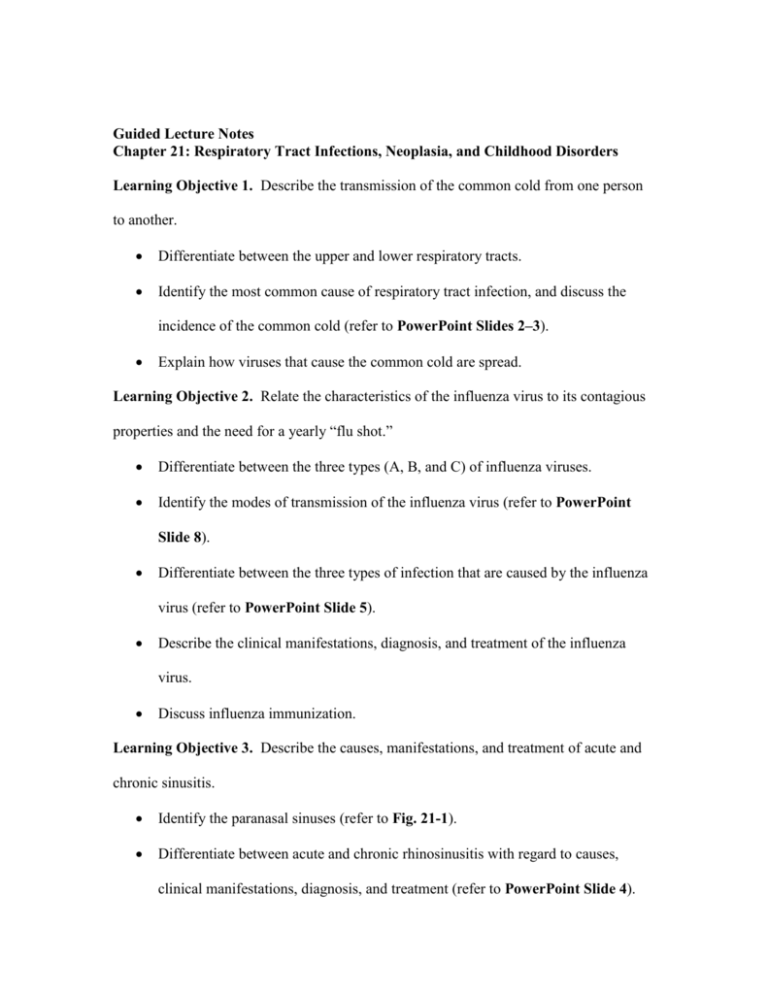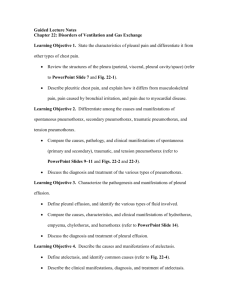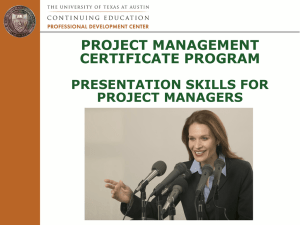Ch21 - Morgan Community College
advertisement

Guided Lecture Notes Chapter 21: Respiratory Tract Infections, Neoplasia, and Childhood Disorders Learning Objective 1. Describe the transmission of the common cold from one person to another. Differentiate between the upper and lower respiratory tracts. Identify the most common cause of respiratory tract infection, and discuss the incidence of the common cold (refer to PowerPoint Slides 2–3). Explain how viruses that cause the common cold are spread. Learning Objective 2. Relate the characteristics of the influenza virus to its contagious properties and the need for a yearly “flu shot.” Differentiate between the three types (A, B, and C) of influenza viruses. Identify the modes of transmission of the influenza virus (refer to PowerPoint Slide 8). Differentiate between the three types of infection that are caused by the influenza virus (refer to PowerPoint Slide 5). Describe the clinical manifestations, diagnosis, and treatment of the influenza virus. Discuss influenza immunization. Learning Objective 3. Describe the causes, manifestations, and treatment of acute and chronic sinusitis. Identify the paranasal sinuses (refer to Fig. 21-1). Differentiate between acute and chronic rhinosinusitis with regard to causes, clinical manifestations, diagnosis, and treatment (refer to PowerPoint Slide 4). Learning Objective 4. Differentiate among community-acquired pneumonia, hospitalacquired pneumonia, and pneumonia in immunocompromised persons in terms of pathogens, manifestations, and prognosis (refer to PowerPoint Slides 10–12). Describe the various classifications of pneumonia (causative agent, site of infection, and setting) (refer to PowerPoint Slide 9 and Fig. 21-2). Define community-acquired pneumonia, and identify the most common causative organisms, risk factors, manifestations, and prognosis. Define hospital-acquired pneumonia, and identify the most common causative organisms, risk factors, manifestations, and prognosis. Discuss pneumonia in immunocompromised persons, and identify the most common causative organisms, risk factors, manifestations, and prognosis. Learning Objective 5. Differentiate between primary tuberculosis and reactivated tuberculosis on the basis of pathophysiology. Discuss the incidence of TB worldwide, and identify the causative agent (refer to PowerPoint Slide 15). Explain how TB is spread. Differentiate between Ghon focus and Ghon complex (refer to PowerPoint Slides 16–17 and Fig. 21-4) Compare the causes, pathophysiology, diagnosis, and treatment of primary and secondary tuberculosis (refer to PowerPoint Slides 19–21 and Fig. 21-5). Learning Objective 6. State the mechanism for the transmission of fungal infections of the lung. Identify classifications and the most common causative organisms of fungal infections. Explain how fungal infections are spread. Compare the clinical manifestations, diagnosis, and treatment of fungal infections and TB. Learning Objective 7. Cite risk factors associated with lung cancer. Discuss the incidence of and survival rates associated with lung cancer. Identify risk factors associated with lung cancer. Learning Objective 8. Differentiate between small-cell lung cancer and non–small-cell lung cancer in terms of histopathology, prognosis, and treatment methods. Compare small-cell lung cancer and non–small-cell lung cancer in terms of histopathology, diagnosis, treatment, and prognosis (refer to PowerPoint Slides 25–26). Learning Objective 9. Describe the manifestations of lung cancer and list two symptoms of lung cancer that are related to the invasion of the mediastinum. Describe the clinical manifestations of lung cancers that involve the lung and adjacent structures, as well as the effects of local metastasis. Learning Objective 10. Define the term paraneoplastic and cite three paraneoplastic manifestations of lung cancer. Explain paraneoplastic syndrome, and identify common systemic manifestations that accompany lung cancer. Learning Objective 11. State the five phases of embryonic and fetal development, and state age for expected survival, including the role of type II alveolar cells and their relation to surfactant. Identify the five stages of embryonic and fetal development, and identify the cells responsible for the production of surfactant. Explain the importance of surfactant to the developing lungs. Learning Objective 12. Cite the possible cause and manifestations of respiratory distress syndrome and bronchopulmonary dysplasia. Describe the cause, pathophysiology, clinical manifestations, and treatment of RDS (Refer to PowerPoint Slide 27 and Fig. 21-9). Explain how RDS may lead to bronchopulmonary dysplasia (refer to PowerPoint Slide 27). Learning Objective 13. Describe the physiologic basis for sternal and chest wall retractions and grunting, stridor, nasal flaring, and wheezing as signs of respiratory distress in infants and small children. Explain the physiologic mechanisms that result in common signs and symptoms of respiratory distress in neonates and small children, including retractions, grunting, stridor, nasal flaring, and wheezing (refer to PowerPoint Slide 30 and Fig. 21-8). Learning Objective 14. Compare croup, epiglottitis, and bronchiolitis in terms of incidence by age, site of infection, and signs and symptoms. Differentiate among epiglottitis, croup, and bronchiolitis (RSV) with regard to causative agent, affected age group, onset, clinical manifestations, and treatment (refer to PowerPoint Slide 31, Fig. 21-10, and Table 21-2). Learning Objective 15. List the signs of impending respiratory failure in small children. Identify the signs of respiratory distress in neonates and small children (refer to Chart 21-1).








